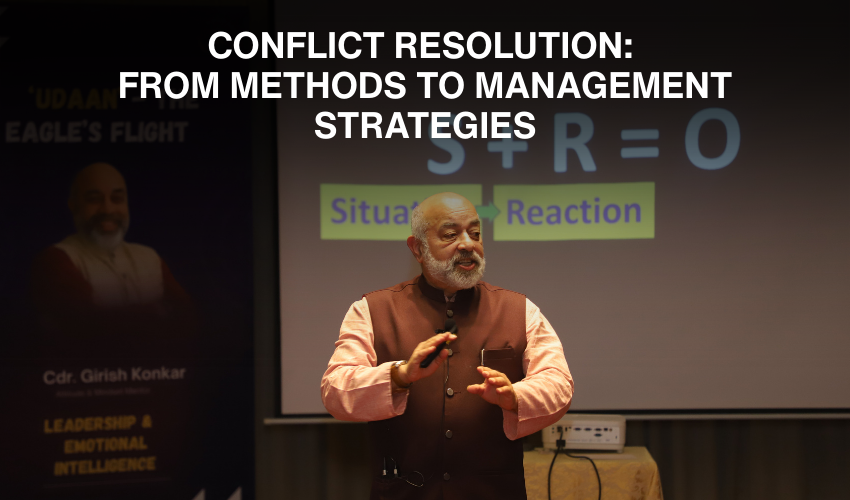
Conflict Resolution: From Methods to Management Strategies
When teams come together, ideas clash. And where ideas clash, conflict resolution becomes essential. I’ve often told leaders that conflict isn’t a sign of failure; it’s a sign of passion, diversity, and growth. The question is not whether conflict exists, it always will, but whether we are prepared to transform it into progress.
Conflict Resolution: Why Leaders Must Pay Attention
Let me share a quick story. A senior leader once told me, “My team is full of arguments, maybe I hired the wrong people.” I asked him, “Would you prefer silence instead?” He smiled, realizing silence might mean disengagement. That is why conflict management and conflict resolution are not about suppression. They are about guiding energy. Leaders who acknowledge friction and encourage dialogue unlock performance instead of bottling it up. Remember this mantra: Respond, don’t act.
Conflict Resolution Methods: Turning Tension into Opportunity
When people ask me about effective conflict resolution methods, I often remind them that one size never fits all. Each situation demands a different lens:
- Collaboration – Sitting everyone at the same table, ensuring all voices are heard, and co-creating solutions.
- Compromise – Meeting halfway, when time or resources are limited.
- Accommodation – Sometimes, letting go of smaller battles to win the war.
- Avoidance – When the issue is minor or emotions are too heated, a pause can be wiser.
- Competition – Necessary when values, ethics, or organizational direction are at stake.
A young manager once confided that he was afraid to confront his team’s mistakes. “I don’t want them to dislike me,” he said. I told him: “Avoiding conflict doesn’t make you popular; it makes you irrelevant.” Using the right conflict resolution methods gave him both authority and respect.
Conflict Resolution Strategies: From Reaction to Prevention
While conflict resolution methods help at the moment, sustainable leadership calls for robust conflict resolution strategies. These are long-term approaches that prevent issues from festering:
- Clarity of Roles: Most conflicts stem from blurred responsibilities. Clear definitions prevent overlap.
- Open Communication: Frequent check-ins and safe spaces reduce misunderstandings.
- Training Leaders in Empathy: Because leaders who listen build trust.
- Values-Driven Culture: When values are explicit, decisions align faster.
Here’s another quick anecdote. During a workshop, one participant shared how his team constantly clashed over deadlines. I asked if the deadlines were ever discussed collaboratively. His silence told me everything. A simple conflict resolution strategy, joint planning, transformed the way his team delivered.
Conflict Management and Conflict Resolution: The Leadership Balance
It’s important to distinguish between conflict management and conflict resolution. Management is about handling tension day to day; resolution is about finding closure. A true leader knows when to manage and when to resolve.
Why does this matter? Because people aren’t machines, they are living, breathing sources of creativity. That’s why we often refer to humans as resources, not for their tasks alone, but for their perspectives. Leaders who respect this bring out the best in every individual.
And when that happens, success is no longer a distant goal, it becomes a daily outcome.
Conflict Resolution Methods vs. Strategies: Choosing Wisely
A key lesson I often emphasize is this: methods are situational; strategies are systemic. For example:
- A heated debate in a meeting may require an immediate method, like cooling the room with humor or mediation.
- A recurring pattern of tension across departments requires a long-term conflict resolution strategy, like restructuring responsibilities or aligning incentives.
Leaders who confuse the two either overreact to small sparks or ignore systemic fires. Balance is an art.
Practical Conflict Resolution Strategies for Leaders
Let me give you some actionable pointers that integrate both conflict resolution methods and long-term conflict resolution strategies:
- Listen Without Judgment: Half the conflict dissolves when people feel heard.
- Frame Disagreements as Shared Goals: Remind the team that conflict is not “me versus you,” but “us versus the problem.”
- Model Calmness: If you stay grounded, others will mirror your behavior.
- Encourage Healthy Debate: Innovation rarely comes from agreement alone.
- Document Agreements: Clarity prevents history from repeating itself.
The Mindset Behind Conflict Management and Conflict Resolution
Ultimately, the mindset is everything. Leaders must see conflict not as disruption but as direction. They must learn to:
- Accept friction as natural.
- Guide discussions toward solutions.
- Encourage diverse viewpoints.
The leaders who thrive are those who respond to friction with empathy, and build bridges rather than walls. They don’t suppress; they channel.
Closing Thought: Conflict as a Catalyst for Success
In the end, the journey from conflict resolution methods to comprehensive conflict resolution
strategies is not just about smoother teams, it’s about stronger organizations.
Conflict teaches us that growth isn’t linear. It’s messy, full of sparks, and often
uncomfortable.
But handled well, it becomes the fuel for innovation, culture, and performance.
And here’s the mentor’s truth: don’t fear conflict, fear indifference. Because in the hands
of a mindful leader, every conflict is an invitation to clarity, connection, and ultimately,
success.
About Coach Girish Konkar
Cdr. Girish Konkar (Retd.) is a former Indian Navy
Submarine Commander turned Leadership & Transformation Coach with over 40 years of
experience across military and corporate arenas.
As CEO of Beyond Horizons, he blends experiential tools like NLP, Psych-K®, etc. with
strategic insight to empower authentic, resilient leaders.





